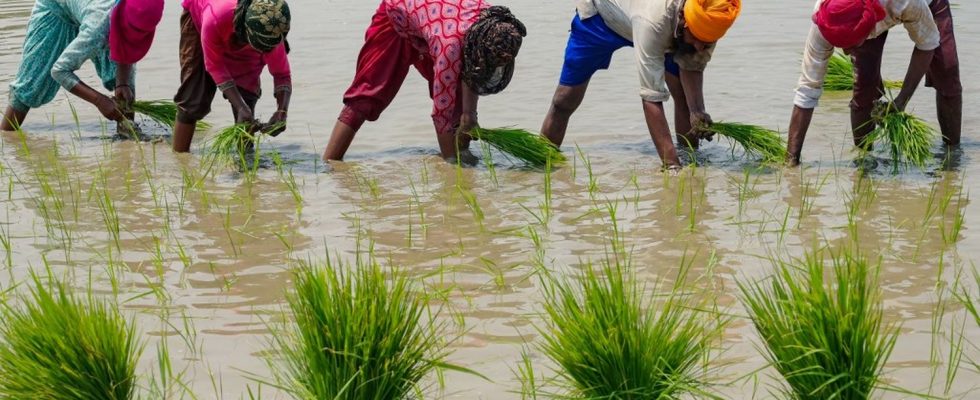The country announced this decision on Friday, which aims to secure the consumption of its population, as prices have risen in recent weeks on the stock markets.
A judgment with global consequences. India has ended its exports of non-basmati white rice “with immediate effect”, announced Thursday, July 20, the Ministry of Consumer Affairs and Food in a press release. In a context where the price of rice has already increased, this decision could further aggravate the situation. Franceinfo answers four questions about the choice of India.
1Why did India decide to stop its exports?
The Indian government pursues two objectives. On the one hand, it is “to guarantee” a supply “sufficient” for local consumers. In the second quarter of 2023, Indian exports of non-basmati white rice jumped 35% year on year, the statement said.
On the other hand, the ministry thus intends “mitigating price increases on the domestic market”while the “retail prices have increased by 11.5% in one year and by 3% in recent months”. Last year, the country exported 10.3 million tonnes of non-basmati white rice, AFP points out.
India’s white non-basmati rice exports account for about a quarter of India’s total rice exports, the news agency adds. India is a heavyweight in the market since it represents nearly 38% of world rice exports, according to a note from the French Ministry of Agriculture (PDF)followed by Thailand and Vietnam (14%).
2Why is the price of rice rising?
New Delhi quotes the “context geopolitics”especially the war in Ukraine, and the “extreme climatic phenomena”, especially El Niño. THE weather phenomenoncharacterized by warmer than normal surface temperatures in the equatorial Pacific Oceanhas caused severe rainfall deficits in Southeast Asian countries, while rice cultivation is particularly water-intensive.
In the case of India, after an episode of drought at the beginning of the year, floods severely damaged crops in July. “The combined effect of these two phenomena is reducing Indian production”, underlines to franceinfo Thierry Pouch, economist at the University of Reims Champagne-Ardenne. However, this decrease should be very limited, according to the researcher: “It will increase to 136 million tonnes in 2023 to just under 135 million tonnes in 2024 according to estimates.
Speculation is another reason for the price increase, according to Patricio Mendez Del Villa, an economist at the Center for International Cooperation in Agricultural Research for Development. “Importing countries seek to fill their stocks, and exporting countries take advantage of this to drive up the bill”he analyzes in Le Figaro.
3What are the consequences on the global market?
India’s decision will lead to an increase “inevitable” prices on international markets, already underway in recent months. “After a fall in prices in July 2022, we are witnessing an unprecedented turnaround”notes Thierry Pouch. “The price of rice per ton is 513 dollars [461 euros] on the month of July 2023whereas in May and June, we were at 470 dollars per ton [422 euros]. This is exactly the same level as in 2008, at the time of the economic and financial crisis.”
In addition, this stoppage of exports risks costing the countries that are most dependent on them dearly. This will “putting importing countries like Benin, Senegal, Turkey or Lebanon in great financial difficulty”, dreads Thierry Pouch. There is a “risk of exacerbating food insecurity” in such states, warned in a note quoted by AFP, the company Gro Intelligence, which analyzes data on raw materials.
For the economist, Russia should take advantage of this situation, while Moscow has decided to suspend the agreement on Ukrainian cereals. “Faced with such high prices, thehe Russia will be able to offer to sell its cereal production [autres que le riz] at a much lower price.”
4Will the price of rice increase in French supermarkets?
Yes, but not “immediately”specifies Thierry Pouch. “The contracts with the distributors were signed on previous prices. When contracts need to be renewed, prices will go up.” He predicts a rise in prices “by fall”. In March 2023, rice was already one of the five products that had increased the most, with a jump of 25% in one year, according to a study by Nielsen IQ for franceinfo. The 500 g package had thus gone to 1.67 euros.
In France, rice is largely imported from Asia, but relatively little from India (21,180 tonnes in 2021/2022), far from Cambodia (83,409) and Thailand (76,191). Italy, however, remains the main supplier (128,262 tonnes), according to data from the French Ministry of Agriculture.
